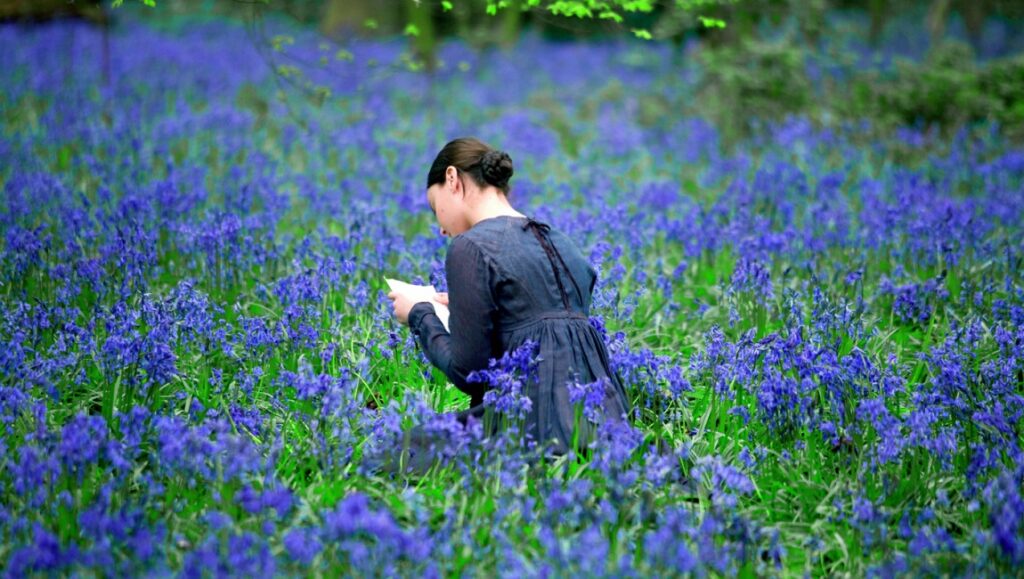Bright Star, Jane Campion’s visually luscious period romance, tells the story of poet John Keats (impish British actor Ben Whishaw), and his immortalized love affair with one-time neighbor and muse, Fanny Brawne (Abbie Cornish). The film, which derives its title from a poem Keats dedicated to Brawne (“Bright star, would that I were as steadfast as thou art”), succeeds, on one level, due to Campion’s decision to avoid biopic tropes. Rather than dwelling on Keats’ life prior to and even apart from Brawne — specifically his medical training, his relationship with his tuberculosis-stricken brother, and even (with few minor exceptions) his specific literary pursuits — Campion’s focus is placed squarely on the love story that became motivation for the work of one of the most celebrated romantics of all time.
Campion sets her film inside the house of Keats’ dearest friend and poetry peer, Charles Armitage Brown (Paul Schneider), and inside the neighboring home of Fanny Brawne’s mother, never allowing the framework of her narrative to leave this established setting even when central characters do: when Keats visits the city, the film remains in Hampstead with the Brawnes and Brown. From this alone, it’s communicated clearly that Bright Star is not your typical biopic, as the camera abandons its most notable character during his absences, and any exploration of Brawne goes little further than her basic love for Keats. During these stretches, the couple’s mutual adoration is realized through letters performed in voiceover, a beautifully affecting touch to a romance primarily built upon — and certainly immortalized through — these specific expressions of love. This technique also allows the film to become a pure love story, one unburdened by the typical contextualization of many period pieces or made more grandiose by the celebrated status of its characters.
Indeed, much of the film’s strength lies in Campion’s handling of its themes. What she seems to prize and what shines through in the film is the reflective beauty of such an innocent and pure affection. In one of his most beloved poems, “Ode on a Grecian Urn,” Keats expresses his belief that the grandest, most emotional and essential moments in life are those immediately preceding the attainment of desire. In Keats’ eyes, to stay frozen in these moments would be heaven. Campion understands this entirely, and her vision of this doomed love is one rife with unadulterated moments of heartening, and sometimes heartbreaking, purity. Brawne and Keats never consummate their love, but indulge themselves in the first steps of their affections so freely and so openly as to suggest a certain childhood innocence (which, really, they were). And yet, the film avoids cynical condemnations of their relationship as Campion meticulously recreates the moments and the minutiae of her lovers’ romance, perfectly capturing the philosophy of the final words of Keats’ “Ode”: “Beauty is truth, truth beauty — that is all / Ye know on earth, and all ye need to know.”
The film’s performances takes their cues from Campion’s prevailing tenor: Abbie Cornish is especially excellent, conveying a mixture of resolve and vulnerability, and establishing Brawne (only 18 in the film) as a truly fascinating and autonomous young woman. The actress perfectly captures her intelligence and early feminist leanings, particularly during her interactions with Brown where her pride fights against her teaching to impress a man so arrogant and sexist. Brawne is defiantly ambitious and progressive, making the dissolution of her exterior callousness when she’s with Keats all the more affecting. Likewise, Whishaw is superbly cast as Keats, abandoning all hint of ego or histrionics in reaching for a much subtler exploration of the romantic era’s most tragic figure. He plays the author not as a man assured in love, but as a man scared and unsettled by the power it holds over him — Whishaw’s Keats is a man slowly unlearning all he thought he knew in the face of his disruptive emotional turmoil. And it’s the perfect complement to Paul Schneider’s turn as poet Brown, whose character is built upon confidence and intellectual superiority (certainly the film’s most showy performance, but one executed with only the occasional misstep).
The film’s craft also thoroughly compliments Campion’s vision and sensibilities. The score is one of the most beautiful in recent years, whether it be the repeated background melodies of a delicate choir or the sparse, unobtrusive splendor of the film’s more emotionally heightened second half. Equally as beautiful is David Hindle’s art direction and D.P. Greig Fraser’s camerawork, which makes heavy use of intimate close-up, before knowingly pulling back at all the right moments to emphasize the film’s emotional breadth and exquisite beauty. In fact, Campion’s handling of all such technical elements is impressively measured, particularly during the film’s quite Malickian midsection, one that captures the couple’s budding love through dialogue-free, score-driven sequences of deftly paced languor, setting moments of simple human communion within nature’s beauty. Predicated on intelligent consideration, Bright Star does more than just continue Campion’s decade of career rejuvenation (after 2003’s superb but markedly different and darker In the Cut) — it reflects the best work of her career. It’s a film rich in tone and somewhat staggeringly pure in spirit that never falls prey to cliché. With a deep care for the literary that will surely appeal to Keats enthusiasts, an affectingly executed love story at the film’s center that will appeal to romantics, and the aesthetic attention that to bear arthouse bona fides, Bright Star is perfectly situated to be an equal opportunity charmer. So it goes when you’re talking about the best film of the year.


Comments are closed.